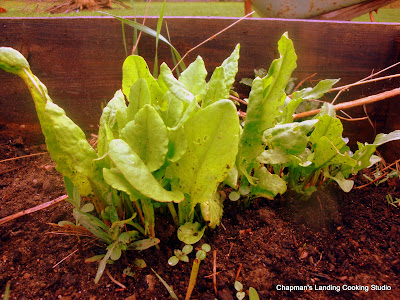I have a lot of broad leaf sorrel (Rumex acetosa) growing in my garden. Sorrel is an early spring perennial and I have been eating from the same patch of plants that I seeded from a single packet 8 years ago. I simply sowed a package of seeds that I bought through mail order from Richter's. I remember being impressed that they came up the next year and early in the season when you are looking for garden foods to add to your salad and soups. It is quite prolific and at various points I have dug up sections and given them to friends and neighbours that enjoy spring greens to start their own patch.
The leaves are best eaten when young and tender. If you trim the plants back they will keep producing all summer and into the fall - otherwise it goes to seed. The photo below shows the garden sorrel mid-June of last year and it is in need of being cut back. As the season progresses it grows as high as a meter.

All sorrels are acidic and sour-tasting. I describe the flavour as lemony and tangy. The name is derived from the French word sur (sour).
The acidity is due to the vitamin C, oxalic acid and oxalate content. The latter substances are responsible for the occasional cases of sorrel poisoning in humans and animals. Most of these have been in Europe where garden sorrel grows wild. Regardless, it is usually recommended that you use sorrel in small amounts. The high oxalic acid content is reduced by cooking. If you have gout, rheumatism or kidney problems you should avoid sorrel.
NUTRITION FACTS (per 250 ml serving): %Daily Values are 15% each of Vitamins A and C and 2% iron. It has 5 calories 0 grams of fat! There will be other nutritional benefits of sorrel but they are not included in my nutrient data base in the software I use.
CULINARY USE: The raw leaves are used in salads. It can also be cooked like spinach. I use sorrel mixed with other greens in soups, omelets, sauces,vinaigrettes etc. I also use it in the recipe for Green Ricotta Pie found at this link.
MEDICINAL USE: according to folk medicine sorrel was infused as a tea to treat kidney and liver ailments. The fresh leaf and rhizome are diuretic, laxative and antiseptic.
FREEZING: you can dry sorrel but it may not have a lot of flavour. It does freeze well. All I do is give a good rinse under cold water and put in a plastic bag, seal and freeze. It can also be frozen in a broth or cooked dishes. You could also make an herb oil puree with olive oil and sorrel alone, or with other greens, and freeze it for later use.
Yours in good taste,
© Nancy Guppy, RD, MHSc
© Nancy Guppy, RD, MHSc


No comments:
Post a Comment